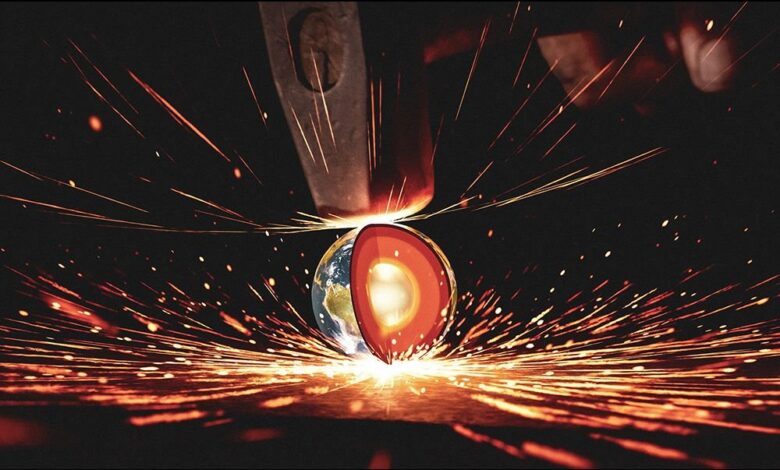Machine learning pinpoints when matter changes under extreme conditions

The phase changes that materials undergo under extreme conditions offer scientists unprecedented opportunities to discover new ways of making materials. Changes can also shed light Formation and composition of exoplanets and other celestial bodies, including our Earth’s inner core.

The phase changes that the material undergoes in experiments under extreme conditions could shed light on the formation and composition of exoplanets and other celestial bodies, including Earth’s inner core. University of Rochester researchers are helping to develop automated deep learning computer vision techniques to expedite the analysis of the trillions of bytes of data generated by these experiments. Illustrated by Greg Stewart / SLAC National Accelerator Laboratory.
However, these phase changes occur in only picoseconds. They also involve modifications to crystalline atomic features that are only a tenth of a nanometer in size.
The paradox for experimental scientists is this: The better they become at recording these changes, or “rare events,” the more they become inundated with “tons” of data. are challenging analysis, Niaz Abdolrahiman assistant professor of Mechanical Engineer in University of Rochester.
For example, just a 10-second test can produce a sequence of millions of images. “I am talking about terabytes (trillions of bytes) of data every day,” she said. Furthermore, only a handful of these images capture the picoseconds at which the phase change occurs, Abdolrahim adds. “Getting humans to analyze these data would be really time consuming and impractical.”
Abdolrahim, a theoretical scientist with expertise in multi-level modeling of nanomaterials, is the principal investigator of two grants — a $574,000 Award from the US Department of Energy’s National Nuclear Security Administration (NNSA) and a $375,000 award from the National Science Foundation (NSF)—awarded to address this issue.
The goal is to develop automated deep learning computer vision techniques that can accelerate this data analysis while rapidly identifying the most important images for experimental scientists.
Her collaborators include city investigator Chenliang Xu, assistant professor of computer scienceand Rip Collins, director of Center for Matter at Atomic Pressuresboth at Rochester, and Arianna Gleason at the Linac Coherent Light Source (LCLS) at the SLAC National Accelerator Laboratory in Menlo Park, CA.
Modeling with ‘aggregated’ data and test data
LCLS and other national laboratories use ultrafast x-ray diffraction spectroscopy to illuminate materials that are undergoing changes at extreme pressures and temperatures. The spectrometer directs an X-ray beam into a crystal structure, or lattice, at extreme conditions. This causes reflections of scattered X-ray beams at picosecond intervals that reveal symmetry, size, and other pertinent atomic features of the structure. Features show up as peaks and halos, indicating whether a phase change has occurred.
Reflections were captured in millions of images for scientists to analyze.

A silicon target undergoes a phase change after exposure to a laser at the SLAC National Accelerator Laboratory. X-ray data captured at a distance of 15 nanoseconds show the dynamics of the lattice. Image credit: SLAC press release for Brennan-Brown et al. Science 2019 Moving on
To create deep learning techniques that can automatically find the best matches among these images, researchers first need to “train” deep learning models with raw data. Ideally, researchers would generate experimental data in state-of-the-art laboratories for this purpose, but that would be expensive and entail too many uncertainties, such as what experiments will be. failed, Abdolrahim explained.
So, in the early stages of the NNSA project, her lab would generate “synthetic data”—data generated by computer simulations as close as possible to what might happen in a given time. actual experiment. “This is where we will work with Xu and his lab to develop a model, modifying it back and forth until it works with our data,” says Abdolrahim.
In the later phases of the project, the researchers will continue to fine-tune the model with actual experimental data in collaboration with LCLS.
“This will tell us, when we look at the X-ray diffraction data, what is the crystal structure of the material, any phase changes that occur during this process, and if they do, at what time,” said Abdolrahim. “Our work will greatly facilitate experimentalists, who can spend a month or more analyzing the data on their own.”
Adjust the framework for larger data sets
With the NSF award, Abdolrahim and her collaborators will adapt their learning models with more complex video segmentation algorithms so that models can be trained on even test datasets. even bigger.
“Here, we will use both 1D (one-dimensional) and 2D (two-dimensional) x-ray diffraction data to determine the dynamics of plastic deformation, phase transformation, and defect generation,” says Abdolrahim.
The project will include performing molecular dynamics simulations to generate 1D and 2D dynamic data, and adapting the model to different types of experimental data with different characteristics.
The overall goal of both projects is “to better understand how materials react at extreme pressures and why new exotic properties or phases occur. This will help us identify new avenues for new material design,” she said.
Both projects were launched with the support of a Undergraduate Research Award (URA) received seed funding from Abdolrahim and Xu. “Without the URA, we might never have started the discussion,” Abdolrahim said. “That’s beneficial for facilitating collaboration and generating these ideas.”
Source: University of Rochester




